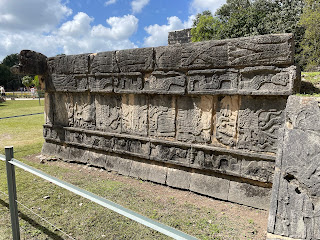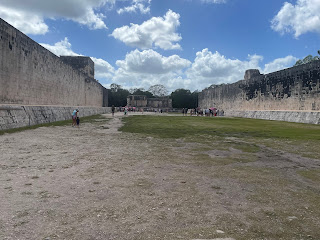After a morning walk along the promenade before breakfast, we packed our bags and set off for a four hour bus ride from Campeche to Merida. But the halfway stop was a nearly three hour tour of the Mayan site at Uxmal.
Uxmal is located in an area with no natural water sources during the dry season. There are no rivers, creeks, streams, lakes, ponds, or wells. But the Mayans constructed hundreds of underground cisterns to capture water during the rainy season.
The storage system was sufficient to see them through the dry season. That, in itself, was a remarkable achievement.
Similarly remarkable is the temple complex. The land here is very flat. But the Mayans, over a period of centuries beginning around 500 C.E. or before, raised two huge platforms more than 20 feet above the mean ground level.
On top of the platforms they constructed amazing buildings. The first one that catches the eye on entering the site is the pyramid to the rain god.
The first temple on this site is quite small, and raised only a few feet above the platform. But at least four other temples were constructed on top of the original. The fifth temple stands about 90 feet above the platform.
Another unique feature of this pyramid is that it really isn't a pyramid at all. It is elliptical in shape, with rounded corners.
Nearby the pyramid is the "Nunnery Quadrangle." This is a name given by the Spaniards, because it reminded them of the cloister of a convent. But there were no nuns here.
Indications are that the four buildings in this quad were a sort of university for elite young people who would become the priests and ruler of the surrounding area.
Our local guide stressed the numerology and the intricate references to the complex Mayan calendar that are everywhere in the carvings and depictions of the structures.
Near the quadrangle is the ball court, which is similar to others we've seen except that one of the goal rings remains intact. The ball court is not on a platform, but at ground level.
Finally, we climbed another, separate platform on which there were two structures. The smaller was called "the house of the turtles" because of the turtle figures on the exterior.
Much larger is the structure archaeologists call "the governor's palace." It obviously had governmental functions, but whether or not there was a "governor" is in dispute.
The palace is perfectly aligned astronomically to the winter solstice and to the ascendancy of the planet Venus. Found nearby was a throne featuring a two-headed jaguar from Mayan mythology.
We were more or less forced to buy lunch on the site. It was billed as "lunch on your own," but there was only one option. Mary and I split a dish.
After the long bus ride, we checked into our hotel and were ready for a bit of relaxation. We went to the pool, but the water was icy cold, despite an air temperature in the mid-90s. We sat by the pool awhile anyway.
At 5 p.m., Balam, our tour leader, took us on an orientation walk around the neighborhood. We are in the heart of the old city, with churches, museums, plazas, restaurants, and shops all around.
The city hall (or Palace Municipal) is an old colonial building that houses the mayor's and other city offices. But it also houses almost two dozen murals by Fernando Castro Pacheco, an artist from Merida who became famous throughout Mexico in the late 20th century.
The murals are stunning. They describe the oppression of the Mayan people by the Spaniards and document various uprisings and rebellions. At first, many of them appear to simply be jumbled colors, but as one looks closely, the figures appear.
The murals also celebrate heroes who helped indigenous people in Mexico to gain equality in the wars for independence and in the Mexican Revolution.
We made a quick stop at the cathedral, then walked across the street to a restaurant called Chaya Maya where we had a very good meal of Mayan dishes.
In the evening, we returned to the main plaza for a show that was supposed to feature Mexican dancing, but it turned out to be a recital of the founding of the city of Merida and the struggles of the Mayans to resist the Spanish.
The program was entirely in Spanish, but English was projected on the wall of a nearby building. Still, it was difficult to read the English and still watch the actors, so we gave up and called it a night.






























































